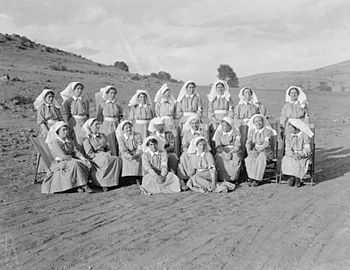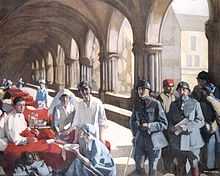Scottish Women's Hospitals

The Scottish Women's Hospitals was founded in 1914. They provided nurses, doctors, ambulance drivers, cooks and orderlies. By the end of World War I 14 medical units had been outfitted and sent to serve in Corsica, France, Malta, Romania, Russia, Salonika and Serbia.
Beginnings
When war broke out in 1914 Elsie Maud Inglis one of the founders of the Scottish Women's Suffrage Federation, suggested that women's medical units should be allowed to serve on the Western Front. With the financial support of the National Union of Women's Suffrage Societies (NUWSS), Inglis formed the Scottish Women's Hospitals Committee. Soon after fundraising commenced. This was highly successfully and by the end of August 1914 they had raised more than five thousand pounds, a quite incredible sum. Inglis met with the War Office to offer the hospital to the British Army but was told that they were not needed. "Go home and sit still, woman" had been the response but, undeterred, the hospital was offered to Britain’s allies. The first to accept were the French and the Belgians who were soon followed by the Serbians, glad to accept due to the dire conditions their soldiers were facing.
France
With quite astonishing speed the first Scottish Women’s Hospital was, in November 1914 staffed, equipped and established at Calais to support the Belgian army. By December a second hospital was based in the ancient Royaumont Abbey. It remained operational throughout the war and treated wounded from the French army under the direction of the French Red Cross. A further hospital was opened at Troyes (Château de Chanteloup, Sainte-Savine) and Villers-Cotterets along with the popular and supportive canteens at Creil, Soissons and Crepy-en-Valois.

Serbia
Also in December, a hospital led by Dr Eleanor Soltau was dispatched to Serbia. Other units quickly followed and Serbia soon had four primary hospitals working night and day. The conditions in Serbia were dire. The Serbian army had a mere 300 doctors to serve more than half a million men and as well as battle casualties the hospital had to deal with a typhus epidemic which ravaged the military and civilian populations. Serbia had fought a surprisingly successful military campaign against the invading Austrians but the fight had exhausted the nation. Both soldiers and civilians were half starved and worn out and in those conditions diseases thrived and hundreds of thousands perished. Four SWH staff, Louisa Jordan, Madge Fraser, Augusta Minshull and Bessie Sutherland died during the epidemic. By the winter of 1915 Serbia could hold out no more. The Austrians had been joined by German and Bulgarian forces and again invaded and the Serbs were forced to retreat into Albania. The SWH staff had a terrible choice to make, stay and go into captivity (or worse) or go with the retreating army into Albania. In the end some stayed and some went. Elsie Inglis, Evelina Haverfield and others were taken prisoner and were eventually repatriated to Britain. The others joined the Serbian army and government in its retreat and suffered the indescribable horrors of that retreat and shared the hardships endured by the Serbian army.
The March
The army retreated over the mountains of Albania and Montenegro in the depths of winter with no food, shelter or help and thousands upon thousands of soldiers, civilians, and prisoners of war died during the retreat. One SWH nurse, Caroline Toughill, was killed when her vehicle ran off the road near Pristina in Kosovo. Those who made it to the safety of the Adriatic sea continued to give what help they could to soldiers, civilians and in particular to the many boys who had joined the retreat. As a direct consequence of this the SWH set up a convalescent hospital in Corsica in December 1915 to help displaced Serb women and children.
Salonika
During this period the hospital at Troyes in France was ordered to pack. Designed as a mobile rather than a fixed hospital and was equipped with tents and vehicles. It was attached to a division of the French army and was despatched to Salonika in Greece when their French division was transferred there as part of a belated move by the allies to provide practical help to the beleaguered Serbs. The hospital (known as the Girton & Newnham Unit after the Cambridge University colleges which funded it) was set up in a disused silkworm factory in the border town of Gevgelia though it soon had to be relocated to the city of Salonika when the rapid Bulgarian advance threatened. Much of the work at Salonika was spent fighting Malaria, a huge killer made worse by the lack of suitable clothing supplied by the allied armies.
It was later joined there by the Ostrovo Unit or the American Unit. This hospital was funded chiefly by American donors and was so named as a thank you to them. The unit was moved 30 miles north of Salonika to Lake Ostrovo and supported the Serbian Army's push back into her homeland. Also sent to Ostrovo was a Transport Column. (This was an ambulance unit which allowed SWH to go a get casualties quickly rather than wait for casualties to be brought to them).
Russia
Following her repatriation to the UK in February 1916 Elsie Maud Inglis set about equipping and staffing a hospital to serve in Russia. Other veterans of the first Serbian hospital including Dr. Lilian Chesney and Evelina Haverfield joined her and a hospital and attendant transport column of ambulances and support vehicles was sent to Russia. It served in southern Russia (Bessarabia and Moldova) and in Romania and provided medical care chiefly to the Serbian Division of the Russian army. This division was made up of ethnic Serbs and other Yugoslavs who had been serving in the Austro-Hungarian army and had been taken prisoner by the Russians and who, after their capture had volunteered to fight for the allies. The Serb division had no medical facilities so these were provided by SWH who had a strong affinity to the Serbian army and people. The SWH staff once again endured the strain and terrible hardship of the war when they had to take part in a chaotic and painful retreat after the Romanian army was routed in 1917. Russia was then plunged into revolution and, when it became clear that the Russian army was unlikely to resume operations, the hospital was withdrawn and sailed from Archangel through submarine infested waters to the UK. Tragically, the day after they arrived back Elsie Inglis, who had been very sick for some time, died. Soon after the Elsie Inglis Unit was established in her memory and sent out to join the Girton & Newnham and the American unit providing medical support to the Serb army in Macedonia. Together they provided much needed help during the campaigns of 1918 which saw the Serbs and their British, French, Russian, Greek and Italian allies drive the Germans, Austro-Hungarians and Bulgarians out of Macedonia and Serbia.
Closing years
Towards the end of the war saw SWH in Serbia itself providing medical help to soldiers, civilians and prisoners of war (as well as continuing to provide care to refugees in Corsica and at the TB hospital in Sallanches in France). A new fixed hospital was established in Vranje for 300 patients but by early 1919 this had been handed over to the Serbian authorities more or less bringing to an end the SWH. While most SWH members went home and resumed their pre war lives many SWH staff and ‘veterans’ chose to stay on to provide much needed medical care in Serbia. Dr. Kathleen McPhail opened a hospital for sick children in Belgrade (and continued this work until forced out by Tito’s government in 1947); Evelina Haverfield ran a hospital for orphans until her tragic death in March 1920; and some did what they could to help, often using their own money, to single handedly help destitute soldiers, refugees or the many orphans and widows who were all in desperate need of help. Others did relief work elsewhere. Isabel Emslie Hutton, for example, went to work with refugees from the Russian civil war in Crimea.
Impact
Over a 1,000 women from many different backgrounds and many different countries served with the SWH. Only the medical professionals such as doctors, nurses, laboratory technicians and x-ray operators received a salary and expenses while non-medical staff such as orderlies, administrators, drivers, cooks and others received no pay at all (and were in fact expected to pay their way). In keeping with the aims of the SWH it was a deliberate policy that, as far as possible, all members of SWH units should be women so allowing opportunities for unqualified women who could nonetheless get the chance to both serve the war effort in some capacity and the cause of women’s rights. Some women joined because it was one of the few opportunities open to women to help the war effort; others saw it as a rare chance for adventure in a world that up till then offered women very few chances; and all shared, with varying degrees, the desire to improve the lot of women. Over half a million pounds was raised by every manner possible to fund the organisation and during the war years it is estimated that hundreds of thousands of patients lives were saved, nursed and helped by these extraordinary, courageous and talented women.
Sources
- Scottish Women's Hospitals
- Women in Uniform, The National Archives
- Scottish Women's Hospital Unit
- Dr Elsie Inglis and the Scottish Women's Hospital
References
- Isabel Galloway Emslie Hutton (1928) With a woman's unit in Serbia, Salonika and Sebastopol Williams and Norgate, London
- McLaren, Eva Shaw (1919) A History of the Scottish Women's Hospitals Hodder and Stoughton, London